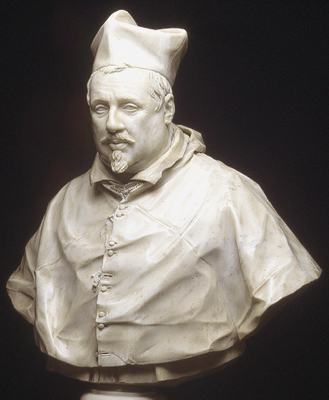The Borghese Gallery and the Fate of an Ill-gotten Collection, Part 1
Do you believe in karma?
What about when it comes to art?
Visiting the extraordinary new exhibit at the Galleria Borghese, which opens in Rome today, I couldn't help but be struck by the irony of situation. Sixty works of art, mostly antiquities, once part of the Borghese collection, have been temporarily returned from their current location at the Louvre in Paris back to their original home at the Boghese Gallery. But how did they get to Paris?
Would you be surprised if I told you Napoleon had something to do with it? But let me start from the beginning...
Rome, 16 May 1605. Camillo Borghese is elected Pope Paul V and immediately names his sister's son, Scipione Caffarella, as Cardinal-Nephew. Not content with being a pope's nephew, Scipione becomes the adopted son of his uncle and is known thereafter as Scipione Borghese. He became the most unscrupulous collector the art world has ever seen.
Scipione must have realized that as Cardinal-Nephew in corrupt 17th-century Rome, he would have more than ample access to any funds he might require, and so he traded his right of inheritance with his cousin Marcantonio, in exchange for every piece in the family's art collection. Despite his position of immense influence, he chose not to involve himself in affairs of state, and instead used his power to satisfy his obsession to possess the world's greatest art.
The collection was already dazzling, but it wasn't enough to satisfy Scipione. He had plans for a marvelous villa, custom built to display the crown jewels of his collection, and he was determined to fill it up. One of his preferred painters was Giuseppe Cesari, better known as Cavalier d'Arpino, a mannerist painter who could boast that Caravaggio had once been his student. In fact, it was d'Arpino who introduced Scipione to the work of Caravaggio, as well as that of Bernini, both of whom would go on to become the cardinal's favorite artists. Since Caravaggio had once worked in d'Arpino's studio, the latter owned a number of Caravaggio's early paintings, and possessed a collection totalling 107 works by various artists. Scipione lusted after d'Arpino's collection (the Caravaggio works in particular) and it didn't take long before he got his hands on it. In 1607, when the artist failed to pay a tax bill, Pope Paul V confiscated his entire collection and gave it to Scipione. The collection included Caravaggio's Boy with a Basket of Fruit and Sick Bacchus, both of which hang in his villa today. If Scipione was addicted to collecting art, then his uncle the Pope was his enabler.
Another Caravaggio painting, Madonna and Child with St. Anne which had been commissioned to be an altarpiece in a chapel in St. Peter's, was appropriated by the cardinal when it was declared by the College of Cardinals to be unfit to hang in the basilica. Documents have suggested that Scipione may have planned it that way from the beginning.
More shocking still is how the Cardinal Borghese ended up with Raphael's sublime Deposition. A gang working for Scipione literally ripped it off the Baglioni Altarpiece in the church of San Francesco in Perugia. The city of Perugia was understandably outraged, and to appease them, Scipione had two copies of the painting by Lanfranco and d'Aprino sent to them. But if you've seen the original, you know the copies couldn't possibly substitute it.
While Bernini was more than willing to be on the cardinal's payroll, pumping out masterpiece after masterpiece, some of his most famous sculptures that still adorn the gallery today, others were not so easily convinced. Cardinal Pietro Aldobrandini had commissioned the sensitive artist Domenichino to paint his triumphant Diana and the Hunt, and when Scipione decided that the work should go to him instead, Domenichino refused to sell it to him. Domenichino was carted off to jail for his lack of cooperation (and probably some invented charges as well) and Scipione got his Diana in the end. Guido Reni, a proud Bolognese through and through, got so sick of the nepotism and corruption rife in Rome, he washed his hands of the Vatican and returned home, only to retrace his steps when the cardinal threatened him with jail as well.
But most horrific of all was his alleged blackmailing of Caravaggio. After over three years on the run due to an unfortunate brawl that left him with blood on his hands and a price on his head, Caravaggio was desperate to return to Rome. As his doting uncle the Pope had recently conferred on him the title of Grand Penitentiary, it was well within Cardinal Borghese's power to pardon Caravaggio, but for months he kept the tortured artist guessing. When the pardon finally came, the 'grateful' Caravaggio sent Scipione a David with the Head of Goliath as gesture of 'thanks'. But Caravaggio wasn't long for this world, and it was on his journey back to Rome that he died, most likely of malaria or fever (although his body was never found), and Scipione snapped up his last two available works to round out his collection.
None of these works are the subject of the Borghese Gallery's new exhibition of course, but to me, the way they were acquired caused the Borghese family to acrue some karmic dept that would be paid back about 200 years later to a short Frenchman with an even greater sense of entitlement than Scipione Borghese, if possible. Part 2 to come tomorrow...








